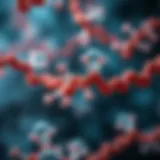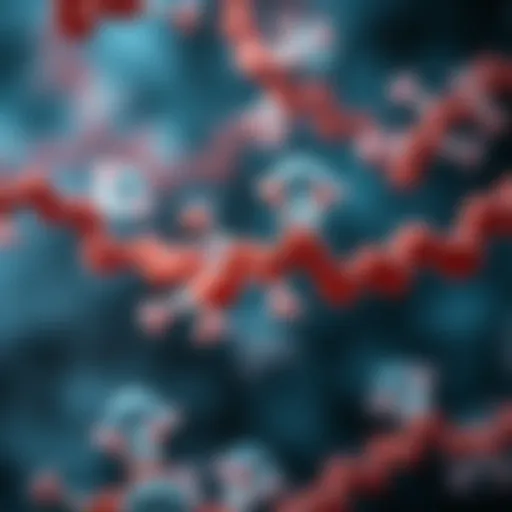Exploring the Intricacies of Rare Kidney Stones


Intro
Kidney stones can be more than just a nuisance; they are a complex medical condition that affects many individuals. Among these stones, the rare varieties pose unique challenges. Understanding the formation, types, and management strategies associated with rare kidney stones is essential for those impacted. This article sets out to dissect this less-charted territory, providing valuable insights into how these unusual stones develop and the implications for individual health.
Research Overview
Summary of Key Findings
The research surrounding rare kidney stones sheds light on several key points:
- Formation Mechanisms: Rare kidney stones often emerge due to specific biochemical processes, which can differ greatly from the common types. These processes include variations in the balance of electrolytes and metabolic irregularities.
- Types of Rare Stones: Stones such as cystine, struvite, or ammonium urate showcase the diverse nature of kidney stones, each stemming from distinct physiological issues.
- Implications for Patients: The presence of rare kidney stones can result in complications, often necessitating tailored management strategies.
Understanding these elements informs both medical professionals and patients about the potential pathways for earlier diagnosis and more effective treatments.
Background and Context
To truly grasp the significance of rare kidney stones, one must consider the broader context of renal health. Kidney stones form when certain substances in urine crystallize and clump together. While most stones are calcium oxalate or uric acid types, rare stones can arise from less common substances. This phenomenon can be linked to genetic factors, dietary habits, and underlying medical conditions.
Moreover, the rising prevalence of kidney stones in general has brought this issue to the forefront of urological research. This article aims to bridge the knowledge gap in understanding rare stones and their impact on individuals and healthcare.
Methodology
Experimental Design
The exploration of rare kidney stones utilized a multifaceted approach, integrating various methods to analyze the formation and characteristics of these stones. Researchers employed both clinical studies and laboratory analyses to gather data, offering a comprehensive overview.
Data Collection Techniques
Data was collected through several techniques, including:
- Urinalysis: to determine the composition of urine and identify potential crystallization factors.
- Imaging Studies: such as ultrasound and CT scans to accurately diagnose the presence of rare kidney stones.
- Patient Interviews: to gather qualitative data about symptoms, dietary patterns, and medical history.
Utilizing these diverse data collection methods ensures a well-rounded understanding of the complexities associated with rare kidney stones.
"Recognizing the unique characteristics of rare kidney stones is crucial in developing tailored treatment plans and improving patient outcomes."
Overall, this analysis endeavors to equip both medical professionals and patients with the knowledge needed to approach rare kidney stones with an informed perspective.
The ensuing sections will delve deeper into the formation processes, specific types of these stones, and potential management strategies.
Understanding Kidney Stones
Understanding kidney stones is essential to grasping the broader implications of kidney health and the challenges faced by individuals who experience this condition. The formation of stones in the kidneys can lead to significant complications, including severe pain and potential long-term damage to this vital organ. By examining kidney stones, we can identify risk factors, recognize symptomatology, and explore treatment strategies. This section serves as a gateway into the anatomy and physiology of kidney stones, establishing a foundation for the subsequent analysis of rare variations.
What Are Kidney Stones?
Kidney stones, often depicted as small, hard mineral deposits, form within the kidneys when certain substances, like calcium or uric acid, become overly concentrated. These deposits can lead to intense discomfort when they pass through the urinary tract. The stones vary significantly in size, from tiny crystals to larger formations that can obstruct the urinary pathway. Understanding the mechanics of stone formation enhances our approach to prevention and management.
Prevalence and Types
Common Types
The common types of kidney stones include calcium oxalate stones and uric acid stones. Calcium oxalate stones are often the most prevalent, forming when calcium combines with oxalate in the urine. One might compare these stones to stubborn weeds in a garden; they tend to pop up frequently and usually arise from dietary factors or metabolic issues. The familiarity of such stones makes them a focus in both prevention and treatment discussions.
Advantages include their well-studied nature, which means there are established guidelines for management. However, their ubiquity can overshadow the rarer, more complex types, prompting a need for deeper exploration into the less common variations.
Rare Types
Rare types of kidney stones encompass stones such as cystine, struvite, and xanthine stones. Cystine stones occur due to a genetic disorder that causes excessive excretion of cystine in urine. They represent a unique challenge since genetic factors play a significant role in their formation. Struvite stones, formed in response to urinary tract infections, highlight the connection between infection and stone development.
One benefit of understanding these rare types is that it can illuminate specific patient conditions that might otherwise go unaddressed. However, their complex formation processes can complicate diagnosis and treatment, necessitating a multidisciplinary approach involving genetics, urology, and dietary consultation.
Formation Process
Supersaturation
Supersaturation refers to a state where certain minerals are present in urine in concentrations that exceed their solubility limits, leading to the crystallization of those substances. This principle is foundational in understanding kidney stone development, akin to how sugar dissolves in hot water but forms crystals when cooled. Recognizing the role of supersaturation brings attention to dietary influences, hydration status, and the balance of electrolytes in urine, creating a framework for preventative strategies.
It signifies not only a biochemical imbalance but also highlights the prevalent issue of insufficient fluid intake in many individuals. Addressing this can greatly reduce the risk of stone formation.
Nucleation
Nucleation is the next step in the stone formation process and can be seen as the initiation of stone development. This involves the aggregation of molecules in supersaturated urine into small crystal clusters. Different forms of nucleation can occur: homogeneous, when crystals form evenly throughout the solution, or heterogeneous, when they form at the surface of existing particles.
Understanding nucleation is critical because it helps explain specific environmental conditions, like urine pH and ionic content, that can either promote or inhibit crystal formation.
Crystal Growth
Once nucleation has occurred, these tiny clusters can grow into larger stones through a process called crystal growth. At this stage, numerous factors such as urine pH and temperature play crucial roles in determining whether the crystals will continue to expand or be flushed out. Crystal growth can be a bit like watching a small snowball roll down a hill, collecting more snow— the same principle applies as stones can accumulate more minerals if conditions remain favorable.
The unique characteristic of this stage is that it allows for targeted interventions. Adjusting dietary habits or medications can effectively slow or stop the growth of renal stones, representing a pivotal point in managing patients prone to recurrence.
Rare Kidney Stones: An Overview
Understanding rare kidney stones is crucial for both medical professionals and patients experiencing these uncommon conditions. Not only do such stones present unique challenges in diagnosis and treatment, but they also provide insights into metabolic and genetic factors that may not be apparent in more common stone types. Recognizing the distinct characteristics of these rare stones facilitates informed clinical decision-making and helps tailor management strategies to the individual needs of patients.
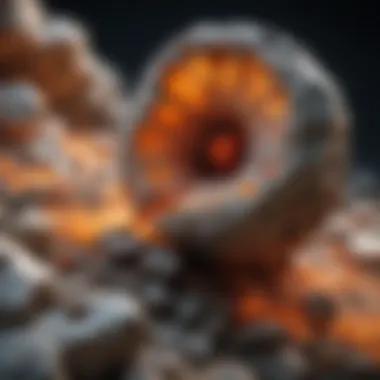
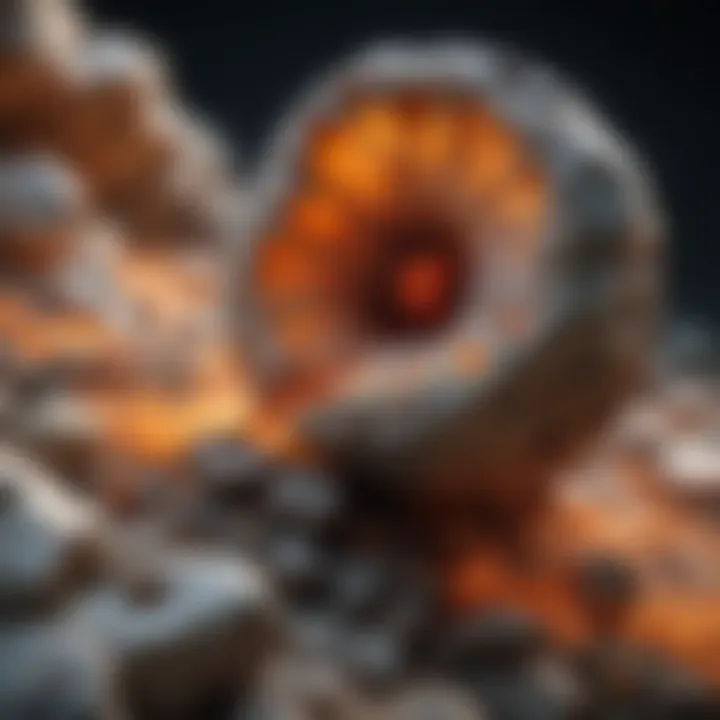
Definition and Distinction
Rare kidney stones are classified as those that occur infrequently compared to more common types, such as calcium oxalate or calcium phosphate stones. The rarity of these stones often leads to a lack of awareness among both healthcare providers and patients.
Removing the veil of obscurity surrounding rare stones allows for better understanding and treatment. They can be comprised of several unusual substances, such as cystine, uric acid, struvite, or xanthine. This section emphasizes recognizing the differences in composition and formation, which can aid in crafting appropriate management plans.
Clinical Significance
Incidence Rates
The incidence rates of rare kidney stones can significantly vary, making them a topic of interest. Statistically, they constitute a small percentage of all kidney stones, but their impact on the affected individuals is often profound. Rare kidney stones can highlight underlying metabolic disorders and genetic predispositions which might be overlooked in patients having recurrent standard stones.
Understanding this aspect of incidence rates can enhance clinicians’ ability to provide comprehensive care. If a patient is found to have a rare type of stone, it might prompt further investigation into metabolic abnormalities. This exploration can unveil additional health concerns that need to be managed, making it a vital aspect of clinical practice related to kidney stone management.
Impact on Patients
The impact on patients with rare kidney stones extends beyond mere physical discomfort. These stones may lead to recurring health issues, including chronic kidney disease or progressive complications if not addressed adequately. The rarity often comes with a lack of straightforward treatment paths, which can result in heightened anxiety for patients who find themselves navigating these uncharted medical waters.
A unique feature of this impact is the psychological burden it places on individuals. Many describe feeling isolated, as their condition may not be widely recognized among peers or even by certain healthcare providers. Thus, addressing both the physical symptoms and the psychological toll is paramount, underscoring the need for holistic management strategies for those facing these unusual stones.
"Rare kidney stones may indicate more than just a singular health issue; they often signal broader metabolic dysfunctions that deserve attention."
This understanding paves the way for a more integrated healthcare approach, aiming to not just treat the symptoms but to fundamentally understand and support the patients behind the medical conditions.
Types of Rare Kidney Stones
Understanding the types of rare kidney stones is crucial, not only for their identification but also for effective management strategies. Recognizing these uncommon formations can aid in tailoring interventions and provide insights into the underlying metabolic abnormalities that contribute to their genesis. Moreover, patients with rare kidney stones often face unique challenges, making it essential for healthcare providers to distinguish between them and their more common counterparts. This understanding can facilitate quicker diagnosis and appropriate treatment approaches, ultimately improving patient outcomes.
Uric Acid Stones
Uric acid stones arise when there is an excess of uric acid in the urine, which can be influenced by certain dietary choices or metabolic conditions. These stones are typically yellowish in color and have a smooth surface. It's important to realize that certain individuals, particularly those with a history of gout or conditions that elevate uric acid levels, are more susceptible to these formations.
Dietary factors play a significant role; foods high in purines, such as organ meats, sardines, and even specific kinds of alcohol, can exacerbate the problem. The primary management strategy for uric acid stones usually involves dietary modification and increased hydration.
"Understanding uric acid stone formation can lead to more effective dietary recommendations, helping patients to manage their condition better and potentially avoid recurrence."
Cystine Stones
Cystine stones are a product of a genetic disorder known as cystinuria, which leads to excessive excretion of the amino acid cystine in urine. Unlike other stones, these tend to be larger and are often yellowish or brown in color. They can occur at a young age and lead to recurrent urinary tract obstructions, emphasizing the need for vigilant management.
Dietary interventions, such as reducing sodium intake and increasing fluid consumption, are essential in managing these stones. Medications may also be prescribed to help reduce cystine levels in the urine.
Struvite Stones
Struvite stones, often associated with urinary tract infections, can grow rapidly and take on complex shapes. They are formed from magnesium, ammonium, and phosphate, usually as a result of urease-producing bacteria. A striking characteristic of struvite stones is their potential to become quite large, leading to significant complications like kidney damage if left untreated.
Management of struvite stones often requires a multifaceted approach involving the treatment of both the stones and the underlying infection. Surgical methods, such as lithotripsy or nephrolithotomy, might be necessary depending on the size and location of the stones.
Xanthine Stones
Xanthine stones are among the rarest types and occur due to the lack of the enzyme xanthine oxidase, leading to elevated levels of xanthine in the urine. They generally have a yellowish appearance and can vary in size. Patients often diagnosed with these stones tend to have a specific metabolic disorder that requires meticulous management.
The treatment for xanthine stones focuses heavily on dietary management, potentially needing long-term adjustments in dietary purine intake. Hydration remains a crucial factor as well. In severe cases, medication might be necessary to help lower xanthine levels.
In summary, comprehending the different types of rare kidney stones is not merely an academic exercise but a necessary aspect of patient care. By tailoring strategies to address each specific type, healthcare providers can help alleviate the enormous burden these stones can place on patients' lives.
Biochemical Pathways in Stone Formation
Understanding the biochemical pathways involved in stone formation is crucial to unraveling the complexities behind rare kidney stones. These pathways encapsulate a variety of mechanisms that contribute to the stone formation process. A closer examination of these factors helps pinpoint the predispositions or triggers that lead to the creation of these unpleasant formations within the renal system. This section will delve into metabolic disorders, dietary influences, and physiological factors, each playing a significant role in the formation of rare kidney stones.
Metabolic Disorders
Metabolic disorders can significantly impact the likelihood of stone formation, especially when they hold hereditary or acquired nature.
Hereditary Factors
Hereditary factors are essential in understanding why certain individuals are more prone to kidney stones. Genetic mutations can affect metabolic pathways related to stone formation, like cystinuria, which leads to excessive cystine in the urine. This becomes a double-edged sword for those affected; on one hand, recognizing a hereditary predisposition arms patients with knowledge to take preventive actions. On the other hand, the unique features associated with genetic conditions can pose challenges in monitoring and managing risks effectively.
For instance, individuals from families with recurrent stone issues might find that lifestyle adjustments—like altering diets or increasing hydration—are beneficial. However, relying solely on these measures may not address the underlying genetic problems.
It is often a family affair when it comes to who’s more likely to suffer from kidney stones due to the intertwined nature of genetics and environmental factors.
Acquired Conditions
Acquired conditions also play a role in stone formation. Factors like obesity, certain metabolic syndromes, and chronic diseases such as diabetes can alter how the body processes waste. For instance, high levels of calcium or oxalate can result from a metabolic response missing the mark due to these conditions.
This contributing factor can be advantageous because it allows healthcare providers to focus on improving overall health to mitigate risks, rather than just treating kidney stones as isolated events. Yet, individuals might face drawbacks here; they may end up managing multiple issues simultaneously, adding complexity to their treatment plans.
Dietary Influences
Dietary choices greatly influence the formation of kidney stones and, therefore, understanding these impacts is pivotal.
High Purine Intake
High purine intake is a significant aspect linked to uric acid stone formation. Foods rich in purines, such as red meat and certain seafood, can surge uric acid levels beyond what the kidneys can adequately filter. While some individuals enjoy the rich flavors these foods bring, they might not realize the hidden costs.
This unique characteristic of high purine consumption leads to potential conditions like gout or renal stones. So, awareness and moderation become key. To keep stone formation at bay, opting for a balanced diet, including more plant-based options, often proves beneficial. The downside is that dietary change doesn’t appeal to everyone, leading them to struggle between cravings and health priorities.
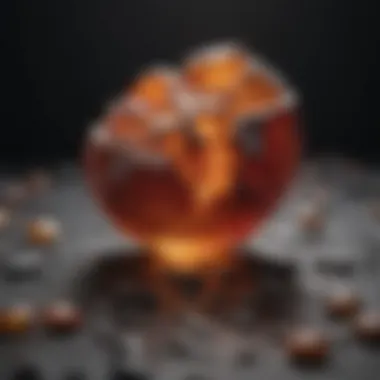

Hydration Status
Hydration status is probably one of the simplest yet most essential factors in kidney stone prevention. Sufficient fluid intake helps dilute substances in urine that lead to stones. The importance of staying well-hydrated cannot be overstated. It’s like giving the kidneys a good wash rather than letting waste build up.
Hydration has the advantage of being easy to control through conscious effort, making it a beneficial choice for individuals at risk of stones. However, individuals might find it challenging to keep up adequate hydration throughout the day, especially if busy.
Physiological Factors
Finally, physiological factors also play a major part in the formation of kidney stones.
pH Level
The pH level of urine can tilt the scales in favor of stone formation. Generally, urine can be either acidic or alkaline, and the composition of stones often correlates with this pH. For instance, acidic urine is known to promote uric acid stones, while alkaline urine encourages calcium phosphate stones. The critical characteristic here is the sensitivity of urinary pH to dietary choices and metabolic conditions.
People often don’t realize how food can impact pH levels. Adopting a diet rich in fruits and vegetables can push the pH level towards a more alkaline state, reducing stone risk. On the other hand, extreme diets, especially those high in acid-forming foods, may tip the balance, leading to possible disadvantages.
Urinary Composition
Urinary composition encompasses a myriad of substances, including calcium, oxalate, and phosphate. Any imbalance can lay the groundwork for stone development. For instance, high calcium or oxalate excretion might indicate a predisposition to certain types of stones, which can be inherited or developed due to specific health issues.
The beauty of understanding urinary composition lies in the possibility of precise interventions through dietary or medicinal means. However, individuals might feel overwhelmed by urine tests and changes in habits, causing stress that can further exacerbate their condition.
Symptoms and Diagnosis
Understanding the symptoms and diagnostic methods associated with rare kidney stones is paramount in managing this challenging health issue. These elements not only assist in identifying the presence of stones but also pave the way for timely interventions that can mitigate complications. Recognizing specific symptoms can give healthcare professionals vital clues regarding the underlying causes and guide appropriate diagnostic techniques to confirm suspicions.
Common Symptoms
Pain
Pain stands as the most notable symptom experienced by individuals dealing with kidney stones, rare or not. It’s a sharp, often debilitating sensation that can manifest suddenly, causing distress and prompting immediate medical attention. Generally, patients report this pain as being located in the flank area, radiating towards the lower abdomen and groin. This characteristic helps distinguish it from other forms of discomfort.
What sets the pain associated with kidney stones apart is its intensity and the pattern it follows. For many, it can come in waves, worsening with time. Such a life-altering symptom signifies the need for intervention, making it an essential topic in this article. Moreover, while pain management is common, understanding its origin can be critical in addressing not only the immediate discomfort but also the underlying causes of stone formation. Thus, the pain becomes not just a symptom but a crucial marker in the journey towards relief and prevention.
Hematuria
Hematuria, or blood in urine, serves as another significant symptom when discussing rare kidney stones. The presence of blood can range from microscopic to readily visible, acting as a telltale sign for patients. The role of hematuria in this context is two-fold. Not only does it indicate potential underlying issues, but it also prompts the need for further investigation into the patient's renal health.
One noteworthy feature of hematuria is that its appearance can vary based on multiple factors, including the size and location of the stones. Unlike typical symptoms, hematuria may not always accompany pain, thus making it a unique identifier in diagnosis. Its significance in this article lies in its ability to alert both patients and healthcare providers to the need for a comprehensive examination, ensuring that appropriate diagnostic measures are undertaken.
Diagnostic Techniques
Imaging Studies
Imaging studies are essential components in diagnosing kidney stones. They provide a detailed view of the stone’s size, location, and number, helping doctors make informed decisions on treatment options. Techniques such as ultrasound, X-rays, and CT scans allow for visualization of the renal anatomy, assisting in identifying not only stones but also any related complications.
Among these methods, the CT scan acts as a gold standard due to its high sensitivity and specificity. It uncovers hidden stones that may go unnoticed with other imaging techniques. Choosing imaging studies emphasizes a proactive approach to kidney stone management, ensuring that the healthcare team has a clear picture of the condition before proceeding with treatment.
Urinalysis
Urinalysis stands out as a crucial diagnostic tool. It provides insights into various aspects of urinary health, including pH, concentration, and the presence of minerals. This swift and non-invasive procedure can reveal critical data, including the composition of the stones and the risk factors contributing to their formation.
One of urinalysis's unique features is its ability to identify metabolic disorders, which can be instrumental in tailoring preventative measures. Its accessibility makes urinalysis a popular choice for initial evaluations, serving as a primary step in understanding a patient's renal health. However, while reliable, it is often used in conjunction with other diagnostic techniques to provide a comprehensive assessment.
In essence, recognizing symptoms and understanding diagnostic methods are pivotal in managing rare kidney stones. Such information not only aids in the identification and treatment of these stones but may also highlight potential areas for lifestyle adjustments that could prevent future occurrences.
Treatment Strategies for Rare Kidney Stones
When it comes to dealing with rare kidney stones, effective management strategies are essential. These strategies not only alleviate symptoms but also target the underlying causes of stone formation. A comprehensive understanding of treatment options allows both healthcare professionals and patients to make informed decisions. In this section, we will explore conservative management, medical interventions, and surgical options, each addressing different needs and contexts to improve outcomes for individuals affected by rare kidney stones.
Conservative Management
Hydration
Hydration is possibly one of the most straightforward yet vital aspects of managing kidney stones. When we talk about maintaining adequate hydration, it directly relates to the volume of fluid intake that helps dilute urine. This dilution plays a key role in reducing the concentration of stone-forming substances. A common recommendation is for individuals to aim for at least two to three liters of water daily. The key characteristic here is that consistent hydration can significantly lower the risk of stone recurrence.
The unique feature of hydration is that it offers a natural and non-invasive method for kidney stone management. However, while increased fluid intake is beneficial, it may not eliminate the stones already present. Additionally, not everyone may find it easy to drink sufficient water, particularly those who are not accustomed to high fluid intake.
Dietary Modifications
Dietary modifications serve as another foundational strategy in the management of rare kidney stones. Adjusting what one eats can effectively mitigate factors leading to stone formation. For instance, reducing foods high in oxalates can be crucial for certain stone types, while those with uric acid stones could benefit from limiting purine-rich foods.
The salient point here is that dietary changes can be a beneficial and preventative measure. For someone keen on avoiding medication or surgical interventions, this can be an appealing route. However, it’s important to note that these adjustments need to be tailored to individual needs. Not everyone reacts the same way to dietary changes, and a poorly planned diet can sometimes lead to unintended consequences.
Medical Intervention
Medications
When conservative methods aren't enough, medications may come into play. Somewhere in the treatment plans, various drugs can be prescribed to either dissolve certain types of stones or prevent their formation. For example, thiazide diuretics might be used for calcium stones, effectively reducing the amount of calcium excreted in urine.
The advantage of medications lies in their ability to target specific issues related to stone types. However, these treatments must be monitored closely by healthcare professionals, as side effects and interactions are possible. In particular, the timeframe for effectiveness may vary widely.
Chemolysis
Chemolysis presents a more specialized medical intervention primarily targeted at specific stone types. It involves using agents that can chemically dissolve stones, particularly uric acid stones, right in the urinary tract. One of the main benefits of this method is that patients may avoid surgery altogether.
That said, chemolysis is generally considered when stones are easily reachable and not too large. Moreover, not all kidney stone types respond to chemolytic agents, and individual cases must be assessed rigorously to avoid complications.
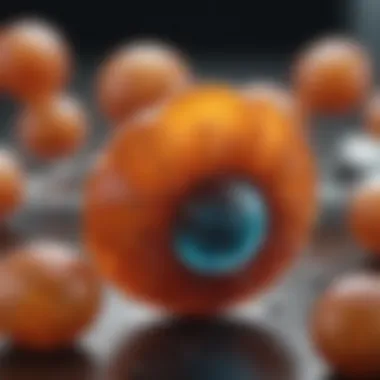

Surgical Options
Lithotripsy
Surgical options become necessary when stones are large or when other treatments have failed. Lithotripsy is often the first surgical line of defense, leveraging sound waves to break stones into smaller pieces that can be passed more easily. This method is less invasive than traditional surgical approaches and is favored for its rapid recovery times.
Despite its advantages, lithotripsy is not without its drawbacks. It may not effectively work on all stone types, and there’s the potential for residual fragments. Hence, follow-up care is crucial following this procedure to ensure complete resolution.
Nephrolithotomy
As a last resort, nephrolithotomy is employed for more complicated cases, where stones are too large or positioned unfavorably for less invasive treatments. In this procedure, a surgeon makes an incision in the skin, allowing direct access to the kidney to remove the stone mechanically. One major advantage is that this method can provide immediate and definitive results. However, it does carry a higher risk of complications and necessitates a longer recovery time compared to other options.
Emerging Research and Innovations
Emerging research and innovations are vital in understanding and managing rare kidney stones. The field is witnessing exciting developments that could not just change treatment protocols but also enhance preventive measures. Novel approaches are being explored each day, shedding light on previously misunderstood mechanisms of stone formation and offering fresh insights into patient management. Keeping up with such developments ensures that patients reap the benefits of advanced knowledge and therapies.
Genetic Studies
One area gaining traction in the realm of rare kidney stones is genetics. Genetic studies aim to identify hereditary factors that contribute to stone formation. As researchers delve into human genetics, they look for specific gene mutations that might predispose individuals to develop these stones.
For instance, certain families exhibit a higher prevalence of cystine stones, indicating a possible genetic component. By pinpointing these genetic markers, clinicians can better assess a patient’s risk profile and possibly develop tailored prevention strategies. Greater understanding in this area can lead to more personalized therapy options, enhancing overall patient care.
Novel Therapeutic Approaches
As science forges ahead, novel therapeutic approaches are also emerging. They encompass a wide range of techniques and medications designed to reduce the burden of rare kidney stones and improve patient outcomes.
Targeted Therapies
One significant aspect of targeted therapies lies in their customized approach to treatment. These therapies are designed to hit specific biological pathways, which are often dysregulated in patients prone to stone formation. For example, targeted enzyme inhibitors may reduce uric acid production, thus lowering the risk of uric acid stones in susceptible individuals.
What makes targeted therapies especially intriguing is their ability to minimize side effects associated with broader treatments. This specificity is a key characteristic that attracts both practitioners and patients looking for efficient alternatives. By focusing on particular mechanisms involved in stone formation, these therapies present a compelling choice for individuals looking to manage their kidney stone condition without the additional baggage of unwanted side effects.
However, an area of consideration remains the high costs associated with these therapies and the need for ongoing research to establish their long-term efficacy.
Biological Treatments
Turning to biological treatments, these approaches leverage the body's own mechanisms to combat stone formation. Utilizing biologics can modulate immune responses or alter inflammatory processes involved in kidney stone pathophysiology. This strategy highlights a key characteristic of biological treatments: the potential to provide long-lasting results by reinforcing the body’s natural defenses.
The unique feature of biological treatments is their versatility. They not only target the stones directly but also address underlying health conditions contributing to stone formation. This comprehensive approach can lead to better overall health outcomes for patients. Nevertheless, the downsides can include variability in patient responses and potential adverse effects that require careful monitoring.
In summary, the field of rare kidney stones is seeing promising advancements with genetic studies and new therapeutic strategies. These innovations hold considerable potential for improving prevention, diagnosis, and treatment in an area of medicine that has historically been challenging to navigate.
Following these research trajectories may bring forward new understandings that could justify significant shifts in how we tackle kidney stones in clinical practice.
Preventive Measures
Preventive measures are crucial in managing the risk of rare kidney stones. Understanding how to reduce the likelihood of stone formation can significantly improve quality of life for individuals susceptible to this condition. Not only do these measures address the immediate concerns related to stone formation, but they also foster long-term health benefits that extend beyond simply avoiding stones.
Risk Assessment
Conducting a risk assessment can pinpoint an individual’s likelihood of developing rare kidney stones. This involves evaluating various factors such as medical history, genetic predispositions, dietary habits, and lifestyle choices.
- Family history can play a role, as certain metabolic or hereditary disorders contribute to stone formation.
- Dietary components, like excessive sodium or animal protein intake, may elevate risk.
- Hydration levels directly affect urinary concentration and pH balance, further impacting potential stone formation.
Identifying these risk factors allows for personalized strategies that mitigate danger. The more aware patients are of their unique circumstances, the better they can tailor their preventive measures.
Lifestyle Modifications
Diet
Diet is a cornerstone in the preventive strategy against kidney stones. A pivotal aspect of dietary management includes ensuring adequate hydration. Drinking sufficient water dilutes the substances in urine that can contribute to stone formation.
A key characteristic of an effective diet involves incorporating foods rich in potassium and magnesium while minimizing calcium oxalate sources—like certain nuts and spinach. This dietary direction isn’t just about restriction, it leans towards a more balanced intake of nutrients that support kidney health. For instance, a diet high in fruits and vegetables aids in lowering acidity levels in urine, which can deter stone creation. However, each individual’s body reacts differently, so some might need to keep an eye on oxalate-rich foods.
On the downside, changing dietary habits can be challenging. It often requires an initial period of readjustment, not to mention the learning curve associated with understanding which foods to include or avoid.
Exercise
Regular exercise also plays a critical role in preventing kidney stones. Physical activity lowers the risk by improving overall metabolism and ensuring effective functioning of the renal system.
- A key characteristic of exercise lies in its ability to maintain a healthy weight. Obesity can increase the chances of stone formation, and thus, engaging in aerobic activities helps manage body weight effectively.
- Another unique aspect of exercise is its influence on hydration. When physically active, people tend to drink more fluids, further diluting substances that could cause stones to form.
However, not every exercise plan may suit someone at risk for kidney stones. Care must be taken to avoid over-exercising without sufficient hydration, particularly in hot weather. Engaging in a variety of exercises can also keep motivation levels high and ensure a rounded fitness approach.
Taking proactive steps in risk assessment and lifestyle modifications lays the groundwork for understanding kidney stone formation and how to mitigate risk effectively.
Closure
The conclusion of this article serves as a vital synthesis of the multifaceted subject concerning rare kidney stones, signifying a thorough understanding of their formation, implications, and management strategies. As the discussion has unfolded, it becomes clear that these stones, while uncommon, present unique challenges to patients and healthcare providers alike.
Summary of Findings
Through meticulous exploration, we’ve highlighted several key findings:
- Diverse Types of Rare Stones: From uric acid to cystine stones, we have outlined how various biochemical pathways contribute to their formation, emphasizing the importance of recognizing these distinctions for proper diagnosis and treatment.
- Clinical Significance: The incidence rates and long-term effects on patients underline the necessity for careful management. The impact of these stones often extends beyond physical health, incorporating emotional and psychological dimensions too.
- Current and Future Treatments: We explored a range of treatment options, from lifestyle modifications to surgical interventions. Importantly, emerging research provides hope for innovative therapies that could enhance patient outcomes.
This collection of findings underscores the broader implications for urology and nephrology, as well as the importance of continued research in this area. With a thorough comprehension of the biochemical and clinical facets, healthcare professionals can better navigate the complex landscape of rare kidney stones.
Future Directions
Looking ahead, the future of rare kidney stone management presents various promising avenues:
- Enhanced Genetic Research: As we delve deeper into genetic predispositions for rare stone formation, we anticipate breakthroughs that could lead to personalized treatment plans based on individual risk factors.
- Novel Therapeutic Approaches: The push for innovative treatments that target specific biochemical pathways offers the potential for significantly improved patient outcomes. These developments could revolutionize current management strategies and lead to more effective prevention measures.
- Interdisciplinary Collaboration: A collaborative approach between nephrologists, dietitians, and geneticists could foster a more comprehensive understanding of the mechanisms behind these stones, optimizing both research and clinical practices.


